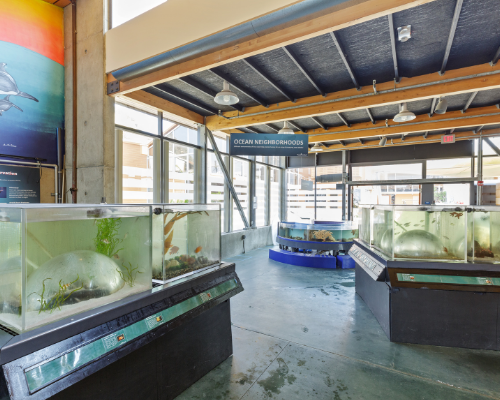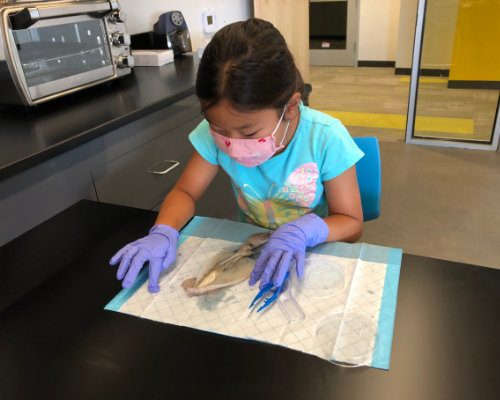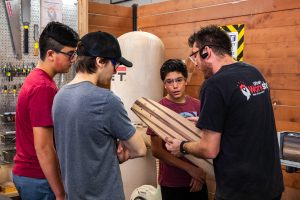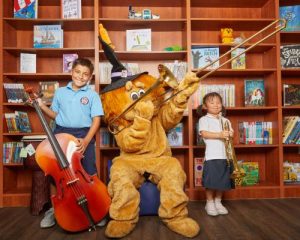How STEM programs survived and continue to thrive in public schools and throughout the county.
The massive, nationwide experiment that was the 2020-2021 school year is now essentially over. Whether parents, teachers or students liked it or not, every student got a taste of being home schooled. The ability to adapt — either financially, technologically or logistically — was often the key to success.
As an entire school year operated on a makeshift plan, some subjects fared better than others. So while it was not a great time to be a P.E. teacher, others were seemingly built for adaptation, among them, STEM courses. But it was hardly easy.
“Troy has been through a series of different teaching arrangements since March [2020],” says Justin Kim, Troy High School’s STEM advisor. “Asynchronous distance, synchronous distance, hybrid, and then back to synchronous distance. I think the ongoing uncertainty has made long-range planning difficult.”
Despite its reputation as a perennial threat for a national Science Olympiad title, Fullerton’s Troy High School represents most schools in their struggle to solve a very big problem and create a scenario that worked for teachers and all students.
“Lab activities have had to be scaled back and/or reimagined,” Kim says. “In-class, hands-on labs, which I have tried a couple while we were in hybrid learning at the end of first semester, is a new challenge. For the in-class students, there is the need for COVID safety including social distancing — no lab groups — and no sharing of equipment. For the at-home students, there is the question of how to keep them engaged with the experiment that they are watching over Zoom.
“Virtual labs and simulations have been more popular,” he says. “There are a range of websites — some better than others — with interactive apps for the full range of the sciences. I have also programmed a couple of my own simple virtual labs for my classes.”
Ultimately every school district and school had to find its own path.
Making It Work
“Teachers in Tustin have worked very hard to use the cameras on student devices, supplemental curriculum and apps, and their classroom tech to engage students and shift what used to be hands-on to a virtual world,” says Tustin Unified School District Assistant Superintendent Grant Litfin. “Teachers are still building vital skillsets with students that are within the subject area, just in a different and safer way.”
The district certainly had one advantage coming into the pandemic, because voters passed Measure S back in 2012, the Technology Bond, that allowed local schools to upgrade their science labs and equipment. Essentially giving every student an iPad or Surface Pro.
“We have been able to make several quick shifts because of these devices and their capabilities,” Litfin says. “One great example is within our world-class robotics programs. Instead of physically building robots and competing in tournaments that require large gatherings, our STEM TOSA and robotics coordinator, Cari Williams, has pivoted our entire program to emphasize coding. In the past, only one student of the five on a typical robotics team would focus on this vital skill while the others build, strategize or drive the robot. This year, all robotics students have built an understanding of coding and have even competed in district-wide coding tournaments. It could be argued the pandemic led to increased exposure to a vital 21st-century skill.”
If any school was ready, any program seemingly designed for social distancing, it was Tustin Connect, the district’s alternative education schools. The two campuses — a K through eighth grade and a high school — offer nearly all their classes online, including a forensic science course.
“The transition was pretty seamless for our students and teachers,” says Tara Bullock, Connect’s lead science teacher. “The collaborative structures we have developed and grown over the past five years have allowed for a more seamless transition to the current situation. We continue to meet with students both in person and online to offer collaborative opportunities for instruction. The use of flipped classrooms, collaborative online environments through the use of a variety of platforms, as well as timely individualized feedback, and personalized instruction are all structures that have allowed our students to continue to thrive despite the struggles they may face outside of the classroom.”
Bullock agrees hands-on labs are important, but how you define “hands-on” can differ.
“We are thankful for technology and make use of Zoom meetings, Google Meets, Pear Deck, online lab simulations and online live demos to meet the needs of our students,” Bullock says. “Online learning can be a struggle for many students, but what we’ve found is the critical step of connecting with our students and the structure of our advisory sections, are critical pieces that we put in place and nurture before any instruction begins.
“The one thing STEM instruction has is that it’s inherently engaging for students. The hands-on nature of the work and opportunity for discovery can be magical for students,” she says. “It helps them to find motivation to complete the work and it is easy for them to see the potential connections to their lives and possible careers.”
The ripple effects of the pandemic altered the approach of museums like Santa Ana’s Discovery Cube Orange County, which routinely offers programs for public schools.
“We reimagined all of our programs that we usually teach in person, such as assemblies, workshops, camps and after-school classes, and turned them into virtual experiences,” says Tina Rolewicz, vice president of education. “We made sure supplies needed for the experience were easily found around the house so that children could still be engaged in hands-on learning. Our education instructors are trained to use a virtual platform as a way to involve children in their learning and not just lecture to them. We use the 5E method of delivering our programs — Engage, Explore, Explain, Elaborate and Evaluate. We are all about children learning by doing — hands-on, minds on instruction. With virtual programs, educators work in teams of two to deliver the most high-quality program. We found they actually have gotten to know each other better, collaborate more, and have learned a lot from their partner educator.”
Troy’s pursuit of a 14th Science Olympiad national title was put on hold in 2020 when the event was canceled. While the outcome for 2021 was not yet known at press time, their 2021 campaign certainly held its own challenges.
“Science Olympiad competition has largely been done virtually/online from home this year. The team has competed in five competitions so far. The virtual nature of the competition means that hands-on laboratory events like Forensics or Circuit Lab have been scaled back and engineering events like Ping Pong Parachute and Wright Stuff have been canceled,” Kim says.
“One benefit of the virtual arrangement is greater flexibility in terms of where we can compete. Since the team is no longer constrained by geography, we have competed in California, Texas, Georgia and Wisconsin already this year against teams from across the country. For most teams, this is traditionally more of a regional/local competition, but has become nationalized. In December, we competed in one ‘satellite’ competition where students came to campus on a Saturday. Tests were proctored by coaches, and engineering devices like Boomilever and Gravity Vehicle could be tested.”
The regular day-to-day preparation changed as well.
“Tryouts, while on campus and in person, were socially distanced with masks on in our new outdoor classroom,” Kim says. “We don’t have the usual after-school practices. Instead, students have to be much more self-motivated. Student leadership is also at a premium this season. And we aren’t traveling, which means students don’t have those same experiences to explore new places or bond with their teammates.”
Despite the challenges, Litfin is encouraged by what he’s seen and optimistic about the future.
“Teachers are continuing to re-write curriculum, find engaging speakers for courses, create contests, develop virtual workshops, create new projects, offer choices to students on how they prove competency, and continue to refine their use of video conferencing tools like Zoom to offer break-out rooms and ways for students to interact and do group projects,” he says. “I have a lot of confidence in the work our teachers and students are doing in TUSD, and I’m sure they will continue to refine their instruction all the way through the end of the year. On the positive end of things, we have seen the resilience of students and teachers in this pandemic, people have gained new skills, and we have found some efficiencies. Many things may never go back to the way they were, and that may be a good thing.”
Maintaining STEM Skills During Summer
Enduring the weirdest school year ever is one thing, but keeping your kids’ interest in STEM, or better yet, helping them discover new topics or skills over the summer is something else.
Bullock, who teaches physics, biology and forensics, suggests families “encourage their children to be inquisitive, ask questions, observe, predict outcomes, experiment and work together to research and figure things out,” she says.
“STEM involves problem-solving, creating or building and explaining how things work. When students are doing these things they are involved in STEM. If I could leave parents with one piece of advise when supporting their children in STEM learning or learning from home at all, would be to support and celebrate their failures. The best learning comes not from the success, but from the continued effort and perseverance to succeed and overcome problems. STEM and the design process are critical to students’ learning and developing the skills to problem-solve. As a parent, it is so hard to watch your students fail, but it can be the greatest gift to empower them and support them to overcome those failures and succeed.”
Wendy Marshall, president and CEO of Dana Point’s Ocean Institute, says the best thing parents can do is essentially the same they can do in any other situation: Foster a love of learning and curiosity. The best way to do that is via discussion.
“You do not need a teaching credential or formal training in education to fulfill this critical role,” Marshall says. “Nor do you need to spend a ton of money to provide your child with the enrichment that can move the needle on academic success and outcomes.
“If we accept that discussions play a vital role in helping our children reach their full potential, Orange County is loaded with enriching experiences that provide opportunities to walk and talk or learn side-by-side, making fertile grounds for discussions that begin with a focus on the moment but can extend to the future.
Look everywhere, says Dizon. “Kids can find STEM all around them — at home, backyard, park, beach, on a road trip, etc. All they need is a little curiosity,” she says. “Be curious, ask questions, observe, do experiments, take notes. Kids can question and do a little research on anything surrounding them, such as nature, bugs, wildlife, weather, electronics, distance/maps and more. Parents can help bring their kids to explore the area safely, and guide/supervise them when doing research and experiments.”
Rolewicz agrees and thinks parents can encourage and stimulate STEM learning simply with whatever is at hand and whatever is going on, because it’s about understanding how or why things work.
“Everything around us has some sort of STEM significance and integrates with real-world applications,” Rolewicz says. “Cooking engages a child in math through measurement and weight, gardening introduces a child to the life cycle of a plant and pollination, recycling and water conservation allows a child to learn about how their behaviors make a difference in our world. We can create STEM experiences for children in everything we do and we have a great resource at discoverycubeconnect.org. It’s free and allows access to hundreds of STEM activities, games, songs and videos that families can do right from the comfort of their own home.
“When it comes to teaching children STEM at home, parents want activities that are simple, easy to do, have step-by-step directions, and are fun.”
Related Posts:
- Stratford School Unveils Its Plan for Fall 2021, Education
- Science and Craft
- Orange County Summer Kid Camps 2022, Kid Activities
STEM Summer Camps Alive and Well in OC
If maintaining your child’s STEM skills and interests at home isn’t enough, there’s good news: Summer camps are here to help.
A wide variety of STEM-stimulating camps are available to parents around the county. From earth science to computer science, there are places for kids to get hands-on experience seeing, touching, doing and learning things they might not even get in normal STEM classroom settings.
Bionerds covers biology topics like insects, plants, humans, genetics, microorganisms and forensics. Kids get up-close experiences with live/preserved organisms, perform dissections and biology experiments/activities using lab tools.
At The Coder School you’ll write computer software and learn about different coding languages and platforms and tools. With no more than two students working with an instructor, it allows customized curriculum for students based on their experience, how they learn, what they’re most interested in learning.
Discovery Cube offers idea-filled opportunities for kids, including early childhood education that helps parents of kids under the age of 5 understand strategies and provides tips to help kids learn, grow and play, using topics like animals, dinosaurs, space, geology and coding.
Galileo camps are designed by age group to optimize innovation in each of the week-long camps. Hands-on projects, outdoor games and an immersive environment are crafted to capture the imagination.
ID Tech spotlights coding for kids and teens through games, art and audio, and special effects with well-known programs like JavaScript, Adobe and others.
Irvine Ranch Conservancy offers recreational and participatory activities to familiarize community members with the richness of the Irvine Ranch landscape, providing them with meaningful experiences that inspire them to care for and protect the land.
Or if marine biology is of interest, the Ocean Institute offers kids a sea lab at home, exploring a variety of topics including ocean science, ocean conservation and maritime history. Lessons include a video resource and things to try at home.
And UC Irvine’s APPcamp, which utilizes the university’s own computer science undergrads as instructors, offers hands-on computer programming projects for learning fundamental coding principles, including how to design, build, test and publish mobile applications.
Ocean Institute President and CEO Wendy Marshall describes “the great pleasure and privilege of seeing families touch sea stars, see a blue whale or sail on a tall ship for the first time together.”
“Our summer camp enrollment says so much. We are 93 percent sold-out, and are adding new sessions to meet demands. Because we have a large campus with quite a bit of outdoor space, as well as two vessels, we are able to keep camps in very small groups, separated from one another. We employed rigorous cleaning, distancing and mask requirements in alignment with CDC standards. It was odd at first to see kids masked, but nature carried the day.”
Mark Freedkin, general manager for The Coder School, says most of their camps will be virtual, via Zoom, with some in-person classes available for parents eager to get their kids out of the house. But for those who can’t quite make it, virtual coding classes include students from as far away as Taiwan.
“First of all, the last 14 months have been inordinately challenging for parents,” Freedkin says. “They got their kids at home and they don’t know what to do with them. We’ve given them a solution for at least, you know, one or two hours a week. For those kids stuck at home sitting in front of a computer and they’re not getting any social interaction, we don’t teach that way. We actually engage them. They’re actually seeing their coach on screen and they’re seeing their coding buddy. So they’re getting social interactions they’ve been missing.”
Bionerds President Diana Dizon anticipates a “somewhat normal” summer in her classes thanks to good old science.
“Science has given us vaccines that enable us to provide our programs with fewer restrictions. We hired new teachers again. Many facilities requested us to come back to offer our camps there. We still follow the current camp guidelines with six feet social distancing, mask wearing, limited capacity, and outdoor/indoor with ventilation preferred, but we are anticipating to be able to include more students in our camps as guidelines restrictions are loosening in the yellow tier phase.”
Tina Rolewicz, vice president of education, plans a mix of virtual and in-person camps with the onsite camps having less children than usual to allow for proper social distancing, as well as some outdoor classes, new air filtration systems, hand-sanitizing stations, and bathrooms with touchless sinks and paper towel dispensers. All counselors are fully vaccinated, and trained to sanitize their work stations and exhibits after each activity.
“Parents, children and educators are feeling some Zoom fatigue,” Rolewicz says. “They are ready to see their kids interacting, learning and playing with other children and people. We are offering a variety of in-person camps and by how quickly our camps are selling out, parents seem to be enthusiastic about seeing their kids out of the house and having fun with STEM.”
By Shawn Price











Leave a Reply